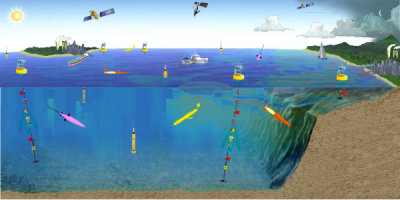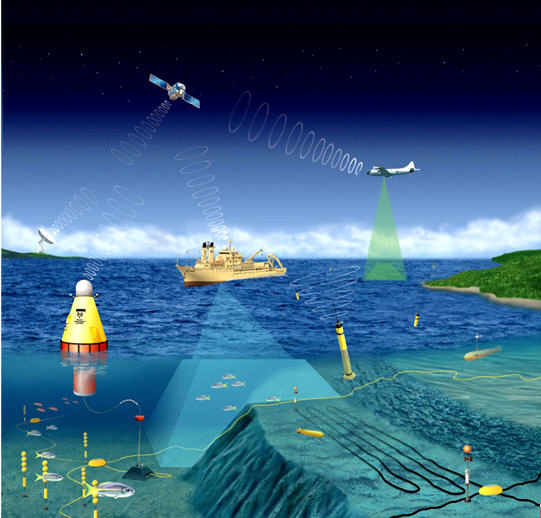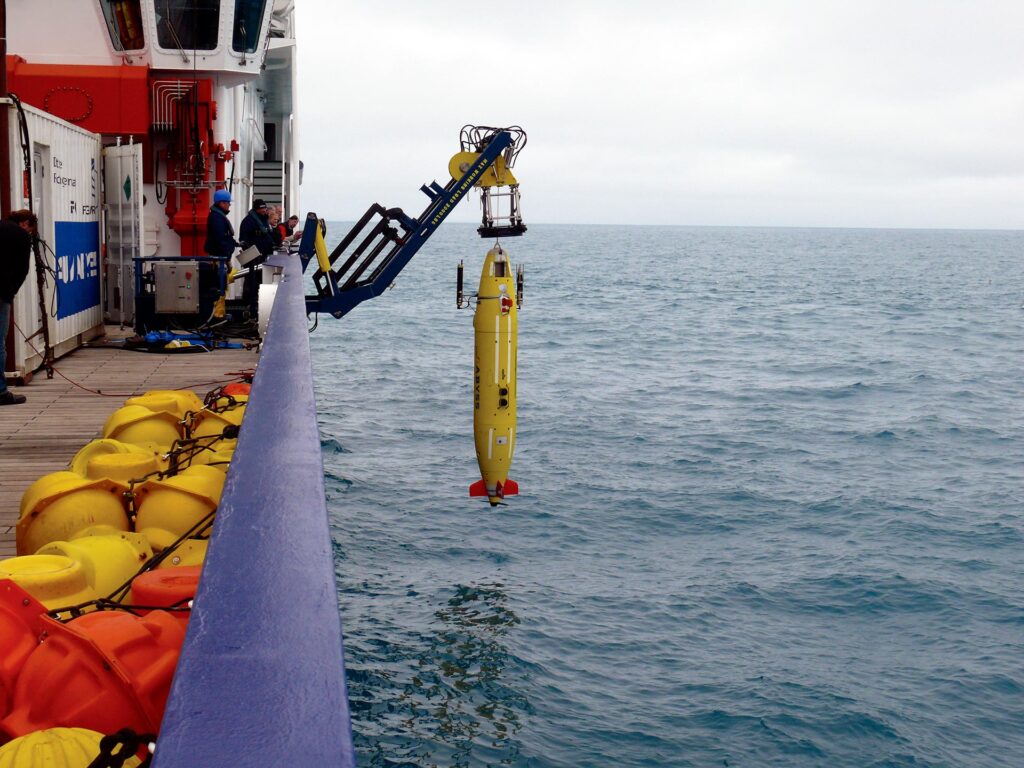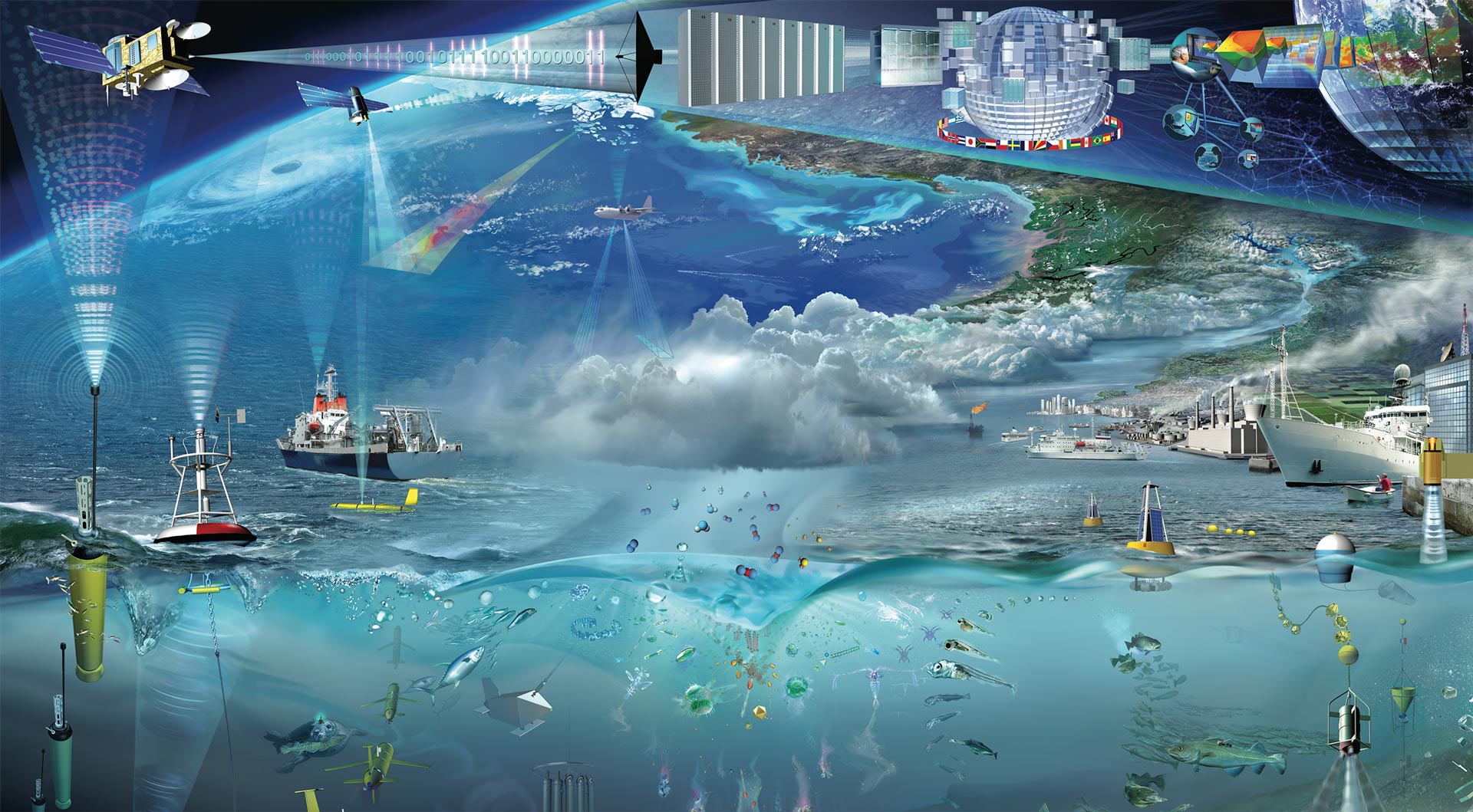Ocean observation is the systematic collection, analysis, and interpretation of data and measurements from the ocean and its surroundings. The goal of ocean observation is to gain a better understanding of the ocean’s physical, chemical, and biological processes, as well as its role in the Earth’s climate system.
Ocean observations can be obtained through a variety of methods, including direct measurements from ships, moored and drifting buoys, autonomous underwater vehicles, satellites, and air-borne platforms. These measurements can include parameters such as temperature, salinity, current velocity, sea level, and ocean color, as well as observations of the atmosphere, sea ice, and marine life.
Ocean observations play a crucial role in a number of areas, including weather forecasting, climate change research, coastal management, and ocean resource management. For example, data on ocean temperatures and currents can be used to improve weather forecasts by providing information on the initial conditions of the atmosphere. In the context of climate change, ocean observations can help us understand how the ocean is absorbing heat and carbon dioxide, and how this is affecting the Earth’s climate.
The systematic collection of ocean observations has only been possible in recent decades, with the development of new technologies and the increasing use of satellites. However, there are still many areas of the ocean that remain poorly observed, particularly in the deep sea and in remote regions. Despite these challenges, ocean observations are becoming increasingly important for understanding and managing the Earth’s ocean and its impact on our planet.
Ocean Observation Systems
Ocean observation systems are the various platforms, technologies, and methods used to collect, measure, and analyze data from the ocean and its environment. These systems play a critical role in understanding the ocean’s role in the Earth’s climate system and in managing its resources.
Some of the key ocean observation systems include:
- Ships: Research ships equipped with scientific instruments have been used for many decades to collect ocean observations. These ships can measure a wide range of parameters, including temperature, salinity, currents, and sea level, as well as conduct surveys of the seafloor and marine life.
- Moored and Drifting Buoys: Moored buoys are anchored to the seafloor and equipped with instruments that measure various ocean parameters. Drifting buoys, also known as drifting profilers, are free-floating and are carried by ocean currents. Both types of buoys provide real-time data on ocean conditions and can be used to track the movement of ocean currents and fronts.
- Autonomous Underwater Vehicles (AUVs): AUVs are self-contained, battery-powered underwater robots that can be programmed to collect ocean data. They can be deployed from ships or from the shore and can operate independently for several days at a time. AUVs can measure a range of parameters, including temperature, salinity, and currents, as well as conduct surveys of the seafloor and marine life.
- Satellites: Satellites provide a unique perspective on the ocean, allowing us to observe its surface and to measure parameters such as sea level, ocean color, and sea ice cover. Satellites also provide data on the atmosphere, which is important for understanding the interactions between the ocean and the atmosphere.
- Airborne Platforms: Airborne platforms, such as airplanes and helicopters, can be equipped with a range of scientific instruments to measure ocean parameters and to survey the ocean and its environment. These platforms can provide data on ocean currents, temperature, and salinity, as well as on the distribution of marine life.

In addition to these platforms, there are also a number of networks and observing systems that bring together data from multiple sources to provide a comprehensive view of the ocean and its environment. Examples include the Global Ocean Observing System (GOOS) and the Argo program, which uses a network of over 3,000 drifting profilers to measure temperature and salinity in the upper ocean.
The use of ocean observation systems has greatly advanced our understanding of the ocean and its role in the Earth’s climate system. However, there are still many areas of the ocean that remain poorly observed, particularly in the deep sea and in remote regions. To address these challenges, ocean scientists are working to develop new technologies and to expand existing observing systems.
Advantages of Ocean Observation Systems
Ocean observation systems provide a wealth of information about the ocean and its environment, which has a number of important benefits. Some of the key advantages of ocean observation systems include:
- Improved weather forecasting: Data collected by ocean observation systems can be used to improve weather forecasts by providing information on the initial conditions of the atmosphere. For example, satellite observations of sea surface temperature can be used to track the formation and movement of ocean currents, which can have a significant impact on weather patterns.
- Enhanced understanding of climate change: Ocean observations play a crucial role in our understanding of the Earth’s climate system. They can help us understand how the ocean is absorbing heat and carbon dioxide, and how these changes are affecting the Earth’s climate. This information is critical for developing effective strategies to mitigate and adapt to the impacts of climate change.
- Better coastal management: Coastal areas are highly vulnerable to the impacts of climate change, such as sea level rise and increased frequency of extreme weather events. Ocean observations can provide important information on these impacts, as well as on the movement of pollutants and harmful algal blooms, which can help to inform coastal management decisions.
- Improved ocean resource management: The ocean is a rich source of resources, including fish, oil, and minerals. Ocean observations can provide important information on the distribution and abundance of these resources, as well as on the impacts of human activities, such as fishing and oil drilling, on the ocean and its ecosystems. This information can be used to support sustainable ocean resource management practices.
- Improved safety and navigation: Ocean observations can also provide important information for navigation and for ensuring the safety of ships and offshore platforms. For example, data on sea level, waves, and currents can help to predict dangerous conditions and to plan safe routes for ships.
- Advancement of scientific knowledge: Finally, ocean observations provide a wealth of information that can be used to advance our scientific understanding of the ocean and its environment. This information can be used to support the development of new theories and models, as well as to inform the design of new experiments and observations.

In conclusion, ocean observation systems play a critical role in our understanding and management of the ocean and its environment. The information they provide is critical for a wide range of activities, from weather forecasting and climate change research to coastal management and ocean resource management.
Disadvantages of Ocean Observation Systems
Despite the many benefits of ocean observation systems, there are also some challenges and limitations associated with their use. Some of the key disadvantages include:
- Cost: One of the biggest challenges of ocean observation systems is the cost of developing, deploying, and maintaining these systems. Many ocean observing platforms, such as research ships and autonomous underwater vehicles, are expensive to build and operate, and require ongoing funding for maintenance and upgrades.
- Technical limitations: Another challenge is the technical limitations of the observing platforms and sensors. For example, many ocean sensors have limited lifetimes and must be periodically replaced, which can be costly and logistically challenging. In addition, some sensors may not be able to function in deep or extreme ocean environments, which can limit their ability to collect important data in these areas.
- Data quality and accuracy: The quality and accuracy of the data collected by ocean observation systems can also be a challenge. For example, the accuracy of sea level observations can be affected by factors such as the calibration of the sensors and the presence of ocean waves. In addition, some ocean observations may be subject to measurement errors or biases, which can affect their reliability.
- Data management and access: Managing and accessing the vast amounts of data generated by ocean observation systems is another challenge. This data must be stored, processed, and analyzed in a manner that allows for easy access and use by the scientific community and other stakeholders. Ensuring the quality and consistency of the data and making it easily accessible to a wide range of users can be a significant challenge.
- Data security: Finally, the security of the data collected by ocean observation systems is a concern. This data can be valuable to a wide range of organizations and individuals, and there is a risk that it could be accessed or misused. Ensuring the confidentiality and privacy of the data and protecting it from unauthorized access is a critical concern for ocean observing programs.
In conclusion, while ocean observation systems provide a wealth of information about the ocean and its environment, there are also a number of challenges and limitations associated with their use. Addressing these challenges will require ongoing efforts to improve the technology, reduce the cost, and ensure the quality and reliability of the data.

Market Value and Demand
The market value and demand for ocean observation systems has grown significantly in recent years, as the need for accurate and reliable information about the ocean and its environment has become increasingly important. There are several factors that have contributed to the growth in market value and demand, including:
- Climate change: The impacts of climate change on the ocean and coastal areas have increased the demand for ocean observations to better understand and respond to these changes. This has driven the development of new observing technologies and platforms, as well as the expansion of existing programs.
- Resource management: The growing demand for ocean resources, such as fish, oil, and minerals, has increased the need for accurate and reliable information about the ocean and its ecosystems. Ocean observation systems play a critical role in supporting sustainable resource management practices.
- Weather and safety: The increasing frequency of extreme weather events and the need to ensure the safety of ships and offshore platforms have also contributed to the growth in demand for ocean observations. Accurate information on sea level, waves, and currents can help to predict dangerous conditions and plan safe routes for ships.
- Research and development: Finally, the advancement of scientific knowledge about the ocean and its environment has also driven the growth in demand for ocean observations. New theories and models require accurate and reliable data to support their development, and ocean observations play a critical role in this process.
In conclusion, the market value and demand for ocean observation systems have grown significantly in recent years, driven by a wide range of factors, including the impacts of climate change, the need for sustainable resource management, and the advancement of scientific knowledge. The growing demand for accurate and reliable information about the ocean and its environment is likely to continue in the future, as the importance of ocean observations for understanding and managing the ocean and its resources becomes increasingly apparent.
Conclude
Ocean observation systems have become increasingly valuable and in-demand in recent years due to the growing significance of understanding the ocean and its resources. Climate change, the need for sustainable resource management, weather and safety concerns, as well as advancements in scientific knowledge, are just some of the factors contributing to this growth.

The future outlook for ocean observation systems remains positive, with a continued demand for accurate and reliable information about the ocean and its environment. This is crucial for managing the ocean’s resources and understanding its impact on the planet and its inhabitants. As a result, the market value and demand for ocean observation systems is expected to remain robust in the years to come.











